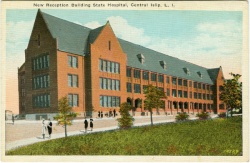Central Islip State Hospital
| Central Islip State Hospital | |
|---|---|
 | |
| Construction Began | 1889 |
| Current Status | Demolished |
| Building Style | Cottage Plan |
| Peak Patient Population | 10,000 est. |
| Alternate Names | Central Islip Psychiatric Center Manhattan State Hospital |
Contents
History
The Central Islip Psychiatric Center started out as a Farm Colony for New York City in 1889. The patients were transferred from the crowded city asylums on Wards, Hart, and Blackwell Island.
Eventually the asylum was taken over by the state and was renamed the Manhattan State Hospital. The campus consisted of 1000 acres and was the largest asylum by land area. Over 100 buildings were built, 2 of which were quite unique. One being several ward groups connected by corridors that stretched approximately one mile long. The elegant architecture and length of the building led to its name as the "String of Pearls." The other complex with a unique layout was called the "Sunburst," which resembled a spoked wheel - the spokes were treatment wards connected to a central hub, with a curved, circular corridor connecting them all. A fire department with 10 employees was created in 1907, and a large medical building and a secure unit were constructed in the middle of the century.
Therapy consisted in working in the farms or one of the many shops. The center had two rail spurs to serve the main power plant (north colony) and the string of pearls (south colony) and even had its own steam engine. Visitors would also arrive by train and the hospital had its own passenger station. The hospital, later renamed to Central Islip State Hospital and finally known as Central Islip Psychiatric Center, began to become severely overcrowded through the 1950s. It reached its peak population of about 10,000 patients in 1955. Lobotomies, various types of shock treatments, and finally drug therapy replaced the long-gone treatments from the 19th century. The population dwindled in the 1970s and 1980s as de-institutionalization took hold, until it finally closed in 1996. The beautiful String of Pearls was demolished for the shopping mall that now stands in its place, the large 1953 power plant was imploded for condominiums in 2006, and the large secure treatment building called Corcoran together with the wooden 1907 firehouse were demolished in 2008. A few buildings have survived, as some of the campus was sold to the New York Institute of Technology and the structures have found a new use by the college.
Power Plant
The Central Islip State Hospital (CISH) Power plant was constructed in 1953 by the Titusville Iron Works Co. and The Interboro Co. It was constructed to meet the rising electrical demands of the expanding psychiatric facility located in Central Islip Long Island New York. The Power plant utilized 3 large turbine generators driven by steam created in water tube boilers heated by coal, then eventually oil. Both fuels were delivered by freight train. The steam that spun the generators was then funneled through a system of pipes housed in underground cement corridors to the various buildings on the psychiatric grounds for heating. The power plant was known as Building number 101 and technically referred to as The Powerhouse. It was the last of 3 power plants constructed on the psychiatric facilities grounds and by far, the largest.
In the mid 1970's, a famous World War II Sherman Tank was discovered buried south of the Power plant.
As de-institutionalization progressed across the United States and commercial power plants on Long Island emerged, The CISH Power plant was eventually relegated to the role of an electrical distribution hub for externally supplied electricity to the few remaining psychiatric buildings still in use. In 1996, The Central Islip State Hospital was closed down and the property and buildings were sold to New York Tech. New York Tech sold off the property on which the CISH Powerplant resided, and in 2006, it was demolished to make room for Condominiums.[1][2][3]
Books
- The farm colonies: Caring for New York City's mentally ill in Long Island's state hospitals, by Leo Polaski


